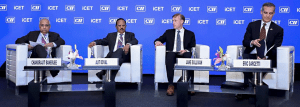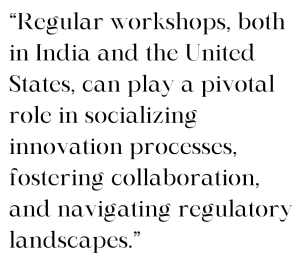Policy Commentary, April 11 2024
By Shibani Mehta

The growing partnership between India and the United States stands out in the quickly changing global partnership environment because both countries have strong military cooperation and a vision for the future that is rich in technological innovation. The acknowledgement of this shared interest at the highest levels of leadership creates the foundation for a strategic embrace that extends beyond government lines and into the corporate sector as both countries work to move up the value chain.
Partnership Core Components
Two essential components of this developing alliance are military cooperation and science and technology. These areas have gained significant traction in the last year, as shown by the volume and kind of interactions between the two countries. As a consequence of a unique alignment of top-level leadership buy-in from both India and the US, tangible results are anticipated. India’s goal to become a technological innovation powerhouse is a major motivator for this partnership. A shift in policy has been triggered by the introduction of iCET, which has caused a surge in several industries, including robotics, drone technology, and space research. The suggested deep tech draft strategy highlights India’s willingness to push boundaries and go into unexplored areas.

Yet, amid these positive developments, a critical gaze at the domestic innovation ecosystem within the industry is imperative. Challenges persist, as exemplified by initiatives such as the iDEX challenge on maritime intelligence capabilities. While grants and awards incentivize start-ups, there is a need to go beyond and demystify processes for the private sector. Regular workshops, both in India and the United States, can play a pivotal role in socializing innovation processes, fostering collaboration, and navigating regulatory landscapes.
Fuelling Innovation & Achieving Results
A specialized agency for military partnership might close the gap between the private sector and government initiatives, taking inspiration from successful models such as the collaboration between the US and India in their space industry. This cooperation would act as a bridge for idea sharing, priority alignment, and regulatory framework traversing in both countries. The GE Aerospace deal transaction serves as an example of a strategic relationship that might prove to be a game-changer for India. Concurrently, the creation of the micron plant serves as evidence of the Indian market’s appeal to US investors. Examining the internal operations of both countries is increasingly essential as the structures for cooperation are put in place. If we work together to improve cooperation, simplify procedures, and foster innovative ecosystems, we can achieve tangible results.
In the future, a mutual willingness in promoting innovation and military cooperation may bring in a new phase of bilateral relations. In addition to taking the India-US relationship to new heights, regular and concentrated workshops, a cooperative defense agency, and a strong emphasis on demystifying procedures will also provide a pattern for global partnerships based on innovation and strategic cooperation.
Remarks made by: Ms. Shibani Mehta, Senior Research Analyst, Carnegie India at First Virtual Panel Discussion on ‘The US-India Political/Strategic Landscape and Its Impact,’ January 18, 2024 for an ongoing project on Partners in Progress: How Does the US-India Strategic Partnership Matter?
Organized by: Centre for East Asian Studies, CHRIST (Deemed to be University) & Rising Powers Initiative, Elliott School of International Affairs, George Washington University in collaboration with US Consulate General, Chennai.
